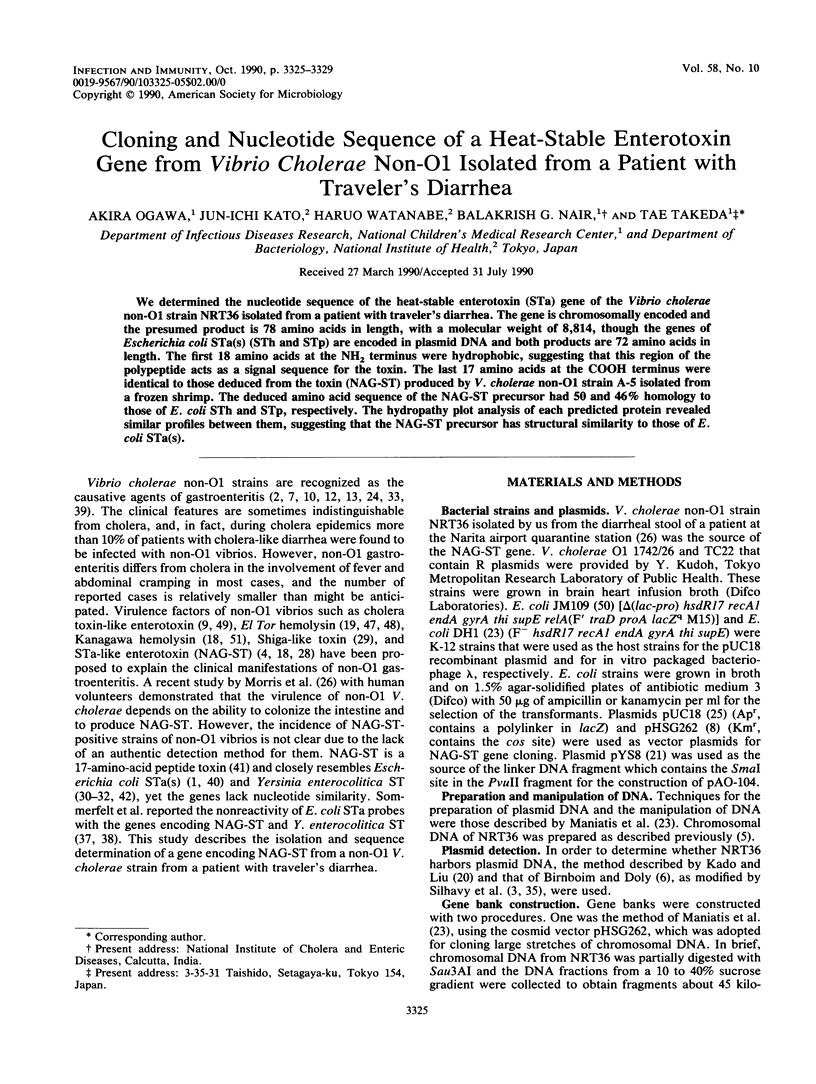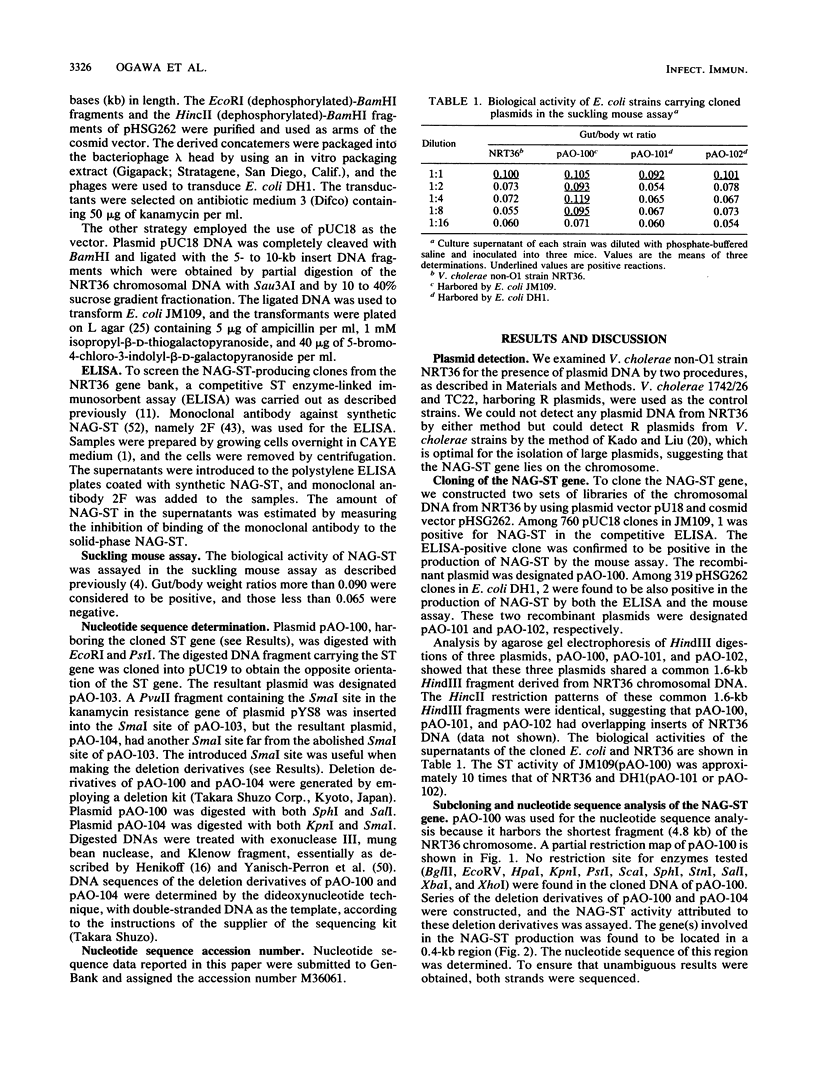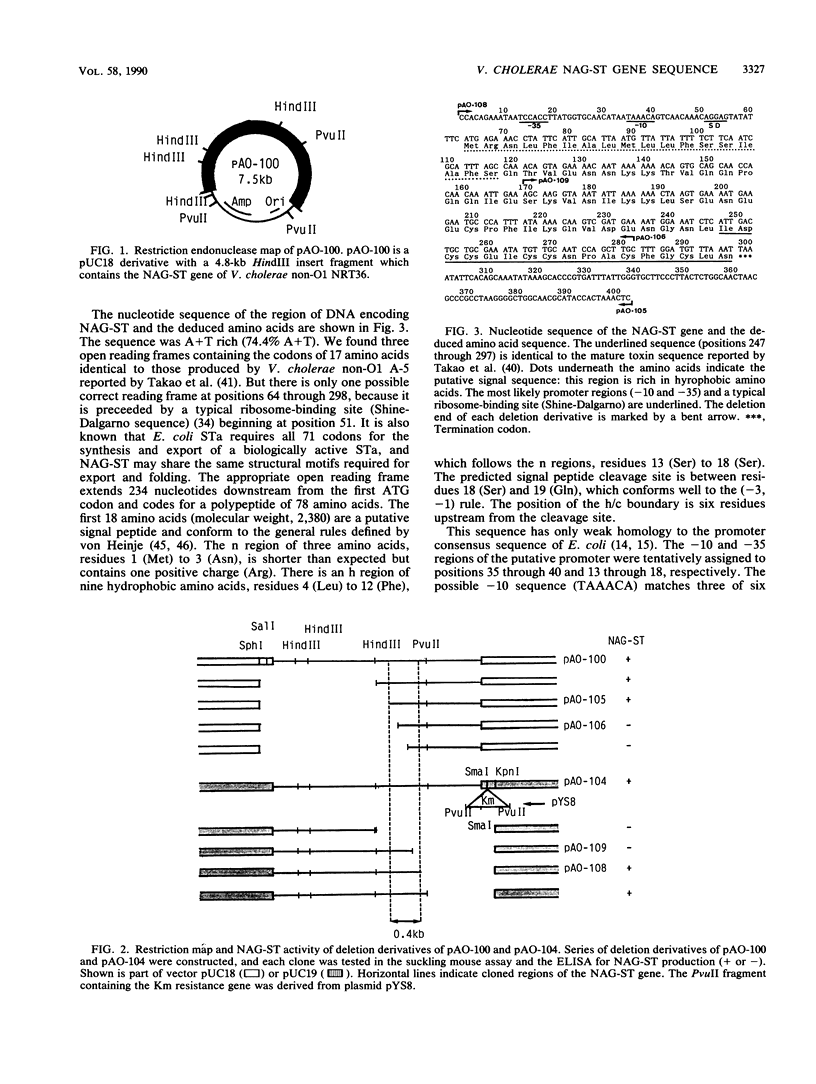Abstract
We determined the nucleotide sequence of the heat-stable enterotoxin (STa) gene of the Vibrio cholerae non-O1 strain NRT36 isolated from a patient with traveler's diarrhea. The gene is chromosomally encoded and the presumed product is 78 amino acids in length, with a molecular weight of 8,814, though the genes of Escherichia coli STa(s) (STh and STp) are encoded in plasmid DNA and both products are 72 amino acids in length. The first 18 amino acids at the NH2 terminus were hydrophobic, suggesting that this region of the polypeptide acts as a signal sequence for the toxin. The last 17 amino acids at the COOH terminus were identical to those deduced from the toxin (NAG-ST) produced by V. cholerae non-O1 strain A-5 isolated from a frozen shrimp. The deduced amino acid sequence of the NAG-ST precursor had 50 and 46% homology to those of E. coli STh and STp, respectively. The hydropathy plot analysis of each predicted protein revealed similar profiles between them, suggesting that the NAG-ST precursor has structural similarity to those of E. coli STa(s).
Full text
PDF




Selected References
These references are in PubMed. This may not be the complete list of references from this article.
- Aimoto S., Takao T., Shimonishi Y., Hara S., Takeda T., Takeda Y., Miwatani T. Amino-acid sequence of a heat-stable enterotoxin produced by human enterotoxigenic Escherichia coli. Eur J Biochem. 1982 Dec 15;129(2):257–263. doi: 10.1111/j.1432-1033.1982.tb07047.x. [DOI] [PubMed] [Google Scholar]
- Aldová E., Láznicková K., Stepánková E., Lietava J. Isolation of nonagglutinable vibrios from an enteritis outbreak in Czechoslovakia. J Infect Dis. 1968 Feb;118(1):25–31. doi: 10.1093/infdis/118.1.25. [DOI] [PubMed] [Google Scholar]
- Amaro C., Aznar R., Garay E., Alcaide E. R plasmids in environmental Vibrio cholerae non-O1 strains. Appl Environ Microbiol. 1988 Nov;54(11):2771–2776. doi: 10.1128/aem.54.11.2771-2776.1988. [DOI] [PMC free article] [PubMed] [Google Scholar]
- Arita M., Takeda T., Honda T., Miwatani T. Purification and characterization of Vibrio cholerae non-O1 heat-stable enterotoxin. Infect Immun. 1986 Apr;52(1):45–49. doi: 10.1128/iai.52.1.45-49.1986. [DOI] [PMC free article] [PubMed] [Google Scholar]
- Birnboim H. C., Doly J. A rapid alkaline extraction procedure for screening recombinant plasmid DNA. Nucleic Acids Res. 1979 Nov 24;7(6):1513–1523. doi: 10.1093/nar/7.6.1513. [DOI] [PMC free article] [PubMed] [Google Scholar]
- Blake P. A., Weaver R. E., Hollis D. G. Diseases of humans (other than cholera) caused by vibrios. Annu Rev Microbiol. 1980;34:341–367. doi: 10.1146/annurev.mi.34.100180.002013. [DOI] [PubMed] [Google Scholar]
- Brady G., Jantzen H. M., Bernard H. U., Brown R., Schütz G., Hashimoto-Gotoh T. New cosmid vectors developed for eukaryotic DNA cloning. Gene. 1984 Feb;27(2):223–232. doi: 10.1016/0378-1119(84)90143-4. [DOI] [PubMed] [Google Scholar]
- Craig J. P., Yamamoto K., Takeda Y., Miwatani T. Production of cholera-like enterotoxin by a Vibrio cholerae non-O1 strain isolated from the environment. Infect Immun. 1981 Oct;34(1):90–97. doi: 10.1128/iai.34.1.90-97.1981. [DOI] [PMC free article] [PubMed] [Google Scholar]
- Dakin W. P., Howell D. J., Sutton R. G., O'Keefe M. F., Thomas P. Gastroenteritis due to non-agglutinable (non-cholera) vibrios. Med J Aust. 1974 Sep 28;2(13):487–490. doi: 10.5694/j.1326-5377.1974.tb70935.x. [DOI] [PubMed] [Google Scholar]
- De Mol P., Hemelhof W., Retoré P., Takeda T., Miwatani T., Takeda Y., Butzler J. P. A competitive immunosorbent assay for the detection of heat-stable enterotoxin of Escherichia coli. J Med Microbiol. 1985 Aug;20(1):69–74. doi: 10.1099/00222615-20-1-69. [DOI] [PubMed] [Google Scholar]
- Dutt A. K., Alwi S., Velauthan T. A shellfish-borne cholera outbreak in Malaysia. Trans R Soc Trop Med Hyg. 1971;65(6):815–818. doi: 10.1016/0035-9203(71)90097-6. [DOI] [PubMed] [Google Scholar]
- Gentz R., Bujard H. Promoters recognized by Escherichia coli RNA polymerase selected by function: highly efficient promoters from bacteriophage T5. J Bacteriol. 1985 Oct;164(1):70–77. doi: 10.1128/jb.164.1.70-77.1985. [DOI] [PMC free article] [PubMed] [Google Scholar]
- Hawley D. K., McClure W. R. Compilation and analysis of Escherichia coli promoter DNA sequences. Nucleic Acids Res. 1983 Apr 25;11(8):2237–2255. doi: 10.1093/nar/11.8.2237. [DOI] [PMC free article] [PubMed] [Google Scholar]
- Henikoff S. Unidirectional digestion with exonuclease III creates targeted breakpoints for DNA sequencing. Gene. 1984 Jun;28(3):351–359. doi: 10.1016/0378-1119(84)90153-7. [DOI] [PubMed] [Google Scholar]
- Hill W. E., Payne W. L., Zon G., Moseley S. L. Synthetic oligodeoxyribonucleotide probes for detecting heat-stable enterotoxin-producing Escherichia coli by DNA colony hybridization. Appl Environ Microbiol. 1985 Nov;50(5):1187–1191. doi: 10.1128/aem.50.5.1187-1191.1985. [DOI] [PMC free article] [PubMed] [Google Scholar]
- Honda T., Arita M., Takeda T., Yoh M., Miwatani T. Non-O1 Vibrio cholerae produces two newly identified toxins related to Vibrio parahaemolyticus haemolysin and Escherichia coli heat-stable enterotoxin. Lancet. 1985 Jul 20;2(8447):163–164. doi: 10.1016/s0140-6736(85)90277-6. [DOI] [PubMed] [Google Scholar]
- Ichinose Y., Yamamoto K., Nakasone N., Tanabe M. J., Takeda T., Miwatani T., Iwanaga M. Enterotoxicity of El Tor-like hemolysin of non-O1 Vibrio cholerae. Infect Immun. 1987 May;55(5):1090–1093. doi: 10.1128/iai.55.5.1090-1093.1987. [DOI] [PMC free article] [PubMed] [Google Scholar]
- Kado C. I., Liu S. T. Rapid procedure for detection and isolation of large and small plasmids. J Bacteriol. 1981 Mar;145(3):1365–1373. doi: 10.1128/jb.145.3.1365-1373.1981. [DOI] [PMC free article] [PubMed] [Google Scholar]
- Kato J., Nishimura Y., Yamada M., Suzuki H., Hirota Y. Gene organization in the region containing a new gene involved in chromosome partition in Escherichia coli. J Bacteriol. 1988 Sep;170(9):3967–3977. doi: 10.1128/jb.170.9.3967-3977.1988. [DOI] [PMC free article] [PubMed] [Google Scholar]
- Kyte J., Doolittle R. F. A simple method for displaying the hydropathic character of a protein. J Mol Biol. 1982 May 5;157(1):105–132. doi: 10.1016/0022-2836(82)90515-0. [DOI] [PubMed] [Google Scholar]
- MCINTYRE O. R., FEELEY J. C., GREENOUGH W. B., 3rd, BENENSON A. S., HASSAN S. I., SAAD A. DIARRHEA CAUSED BY NON-CHOLERA VIBRIOS. Am J Trop Med Hyg. 1965 May;14:412–418. doi: 10.4269/ajtmh.1965.14.412. [DOI] [PubMed] [Google Scholar]
- Morris J. G., Jr, Takeda T., Tall B. D., Losonsky G. A., Bhattacharya S. K., Forrest B. D., Kay B. A., Nishibuchi M. Experimental non-O group 1 Vibrio cholerae gastroenteritis in humans. J Clin Invest. 1990 Mar;85(3):697–705. doi: 10.1172/JCI114494. [DOI] [PMC free article] [PubMed] [Google Scholar]
- Moseley S. L., Hardy J. W., Hug M. I., Echeverria P., Falkow S. Isolation and nucleotide sequence determination of a gene encoding a heat-stable enterotoxin of Escherichia coli. Infect Immun. 1983 Mar;39(3):1167–1174. doi: 10.1128/iai.39.3.1167-1174.1983. [DOI] [PMC free article] [PubMed] [Google Scholar]
- Nishibuchi M., Seidler R. J., Rollins D. M., Joseph S. W. Vibrio factors cause rapid fluid accumulation in suckling mice. Infect Immun. 1983 Jun;40(3):1083–1091. doi: 10.1128/iai.40.3.1083-1091.1983. [DOI] [PMC free article] [PubMed] [Google Scholar]
- O'Brien A. D., Chen M. E., Holmes R. K., Kaper J., Levine M. M. Environmental and human isolates of Vibrio cholerae and Vibrio parahaemolyticus produce a Shigella dysenteriae 1 (Shiga)-like cytotoxin. Lancet. 1984 Jan 14;1(8368):77–78. doi: 10.1016/s0140-6736(84)90006-0. [DOI] [PubMed] [Google Scholar]
- Okamoto K., Inoue T., Shimizu K., Hara S., Miyama A. Further purification and characterization of heat-stable enterotoxin produced by Yersinia enterocolitica. Infect Immun. 1982 Mar;35(3):958–964. doi: 10.1128/iai.35.3.958-964.1982. [DOI] [PMC free article] [PubMed] [Google Scholar]
- Pai C. H., Mors V. Production of enterotoxin by Yersinia enterocolitica. Infect Immun. 1978 Mar;19(3):908–911. doi: 10.1128/iai.19.3.908-911.1978. [DOI] [PMC free article] [PubMed] [Google Scholar]
- Shine J., Dalgarno L. The 3'-terminal sequence of Escherichia coli 16S ribosomal RNA: complementarity to nonsense triplets and ribosome binding sites. Proc Natl Acad Sci U S A. 1974 Apr;71(4):1342–1346. doi: 10.1073/pnas.71.4.1342. [DOI] [PMC free article] [PubMed] [Google Scholar]
- So M., McCarthy B. J. Nucleotide sequence of the bacterial transposon Tn1681 encoding a heat-stable (ST) toxin and its identification in enterotoxigenic Escherichia coli strains. Proc Natl Acad Sci U S A. 1980 Jul;77(7):4011–4015. doi: 10.1073/pnas.77.7.4011. [DOI] [PMC free article] [PubMed] [Google Scholar]
- Sommerfelt H., Kalland K. H., Raj P., Moseley S. L., Bhan M. K., Bjorvatn B. Cloned polynucleotide and synthetic oligonucleotide probes used in colony hybridization are equally efficient in the identification of enterotoxigenic Escherichia coli. J Clin Microbiol. 1988 Nov;26(11):2275–2278. doi: 10.1128/jcm.26.11.2275-2278.1988. [DOI] [PMC free article] [PubMed] [Google Scholar]
- Sommerfelt H., Svennerholm A. M., Kalland K. H., Haukanes B. I., Bjorvatn B. Comparative study of colony hybridization with synthetic oligonucleotide probes and enzyme-linked immunosorbent assay for identification of enterotoxigenic Escherichia coli. J Clin Microbiol. 1988 Mar;26(3):530–534. doi: 10.1128/jcm.26.3.530-534.1988. [DOI] [PMC free article] [PubMed] [Google Scholar]
- Takao T., Hitouji T., Aimoto S., Shimonishi Y., Hara S., Takeda T., Takeda Y., Miwatani T. Amino acid sequence of a heat-stable enterotoxin isolated from enterotoxigenic Escherichia coli strain 18D. FEBS Lett. 1983 Feb 7;152(1):1–5. doi: 10.1016/0014-5793(83)80469-4. [DOI] [PubMed] [Google Scholar]
- Takao T., Shimonishi Y., Kobayashi M., Nishimura O., Arita M., Takeda T., Honda T., Miwatani T. Amino acid sequence of heat-stable enterotoxin produced by Vibrio cholerae non-01. FEBS Lett. 1985 Dec 2;193(2):250–254. doi: 10.1016/0014-5793(85)80163-0. [DOI] [PubMed] [Google Scholar]
- Takao T., Tominaga N., Shimonishi Y., Hara S., Inoue T., Miyama A. Primary structure of heat-stable enterotoxin produced by Yersinia enterocolitica. Biochem Biophys Res Commun. 1984 Dec 28;125(3):845–851. doi: 10.1016/0006-291x(84)91360-3. [DOI] [PubMed] [Google Scholar]
- Takeda T., Nair G. B., Suzuki K., Shimonishi Y. Production of a monoclonal antibody to Vibrio cholerae non-O1 heat-stable enterotoxin (ST) which is cross-reactive with Yersinia enterocolitica ST. Infect Immun. 1990 Sep;58(9):2755–2759. doi: 10.1128/iai.58.9.2755-2759.1990. [DOI] [PMC free article] [PubMed] [Google Scholar]
- Toranzo A. E., Barja J. L., Colwell R. R., Hetrick F. M. Characterization of plasmids in bacterial fish pathogen. Infect Immun. 1983 Jan;39(1):184–192. doi: 10.1128/iai.39.1.184-192.1983. [DOI] [PMC free article] [PubMed] [Google Scholar]
- Yamamoto K., Al-Omani M., Honda T., Takeda Y., Miwatani T. Non-O1 Vibrio cholerae hemolysin: purification, partial characterization, and immunological relatedness to El Tor hemolysin. Infect Immun. 1984 Jul;45(1):192–196. doi: 10.1128/iai.45.1.192-196.1984. [DOI] [PMC free article] [PubMed] [Google Scholar]
- Yamamoto K., Ichinose Y., Nakasone N., Tanabe M., Nagahama M., Sakurai J., Iwanaga M. Identity of hemolysins produced by Vibrio cholerae non-O1 and V. cholerae O1, biotype El Tor. Infect Immun. 1986 Mar;51(3):927–931. doi: 10.1128/iai.51.3.927-931.1986. [DOI] [PMC free article] [PubMed] [Google Scholar]
- Yamamoto K., Takeda Y., Miwatani T., Craig J. P. Evidence that a non-O1 Vibrio cholerae produces enterotoxin that is similar but not identical to cholera enterotoxin. Infect Immun. 1983 Sep;41(3):896–901. doi: 10.1128/iai.41.3.896-901.1983. [DOI] [PMC free article] [PubMed] [Google Scholar]
- Yanisch-Perron C., Vieira J., Messing J. Improved M13 phage cloning vectors and host strains: nucleotide sequences of the M13mp18 and pUC19 vectors. Gene. 1985;33(1):103–119. doi: 10.1016/0378-1119(85)90120-9. [DOI] [PubMed] [Google Scholar]
- Yoshimura S., Takao T., Shimonishi Y., Hara S., Arita M., Takeda T., Imaishi H., Honda T., Miwatani T. A heat-stable enterotoxin of Vibrio cholerae non-01: chemical synthesis, and biological and physicochemical properties. Biopolymers. 1986;25 (Suppl):S69–S83. [PubMed] [Google Scholar]
- von Heijne G. How signal sequences maintain cleavage specificity. J Mol Biol. 1984 Feb 25;173(2):243–251. doi: 10.1016/0022-2836(84)90192-x. [DOI] [PubMed] [Google Scholar]
- von Heijne G. Signal sequences. The limits of variation. J Mol Biol. 1985 Jul 5;184(1):99–105. doi: 10.1016/0022-2836(85)90046-4. [DOI] [PubMed] [Google Scholar]


